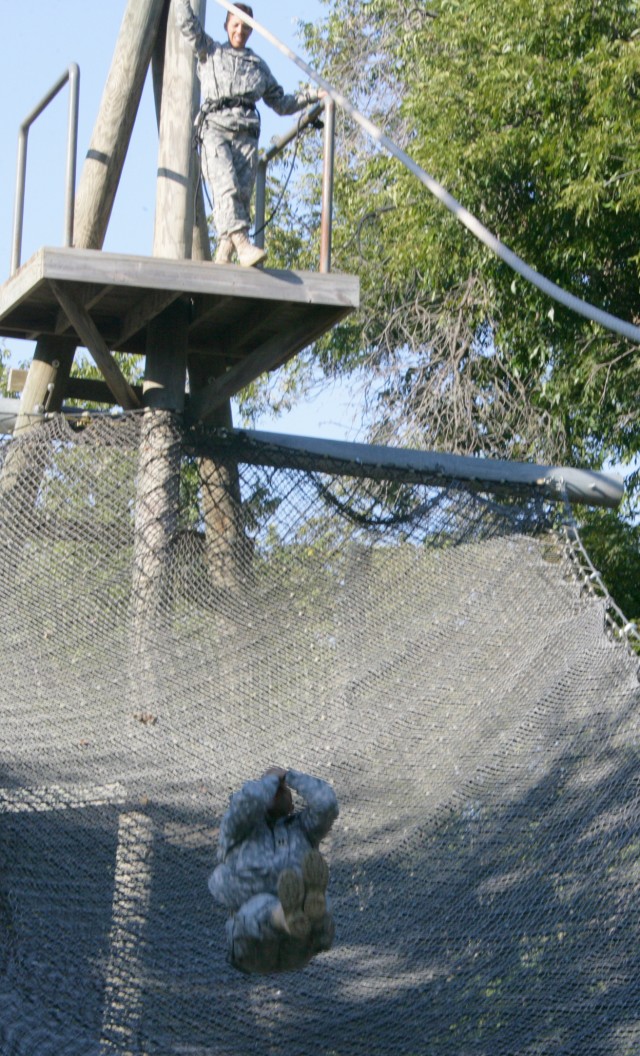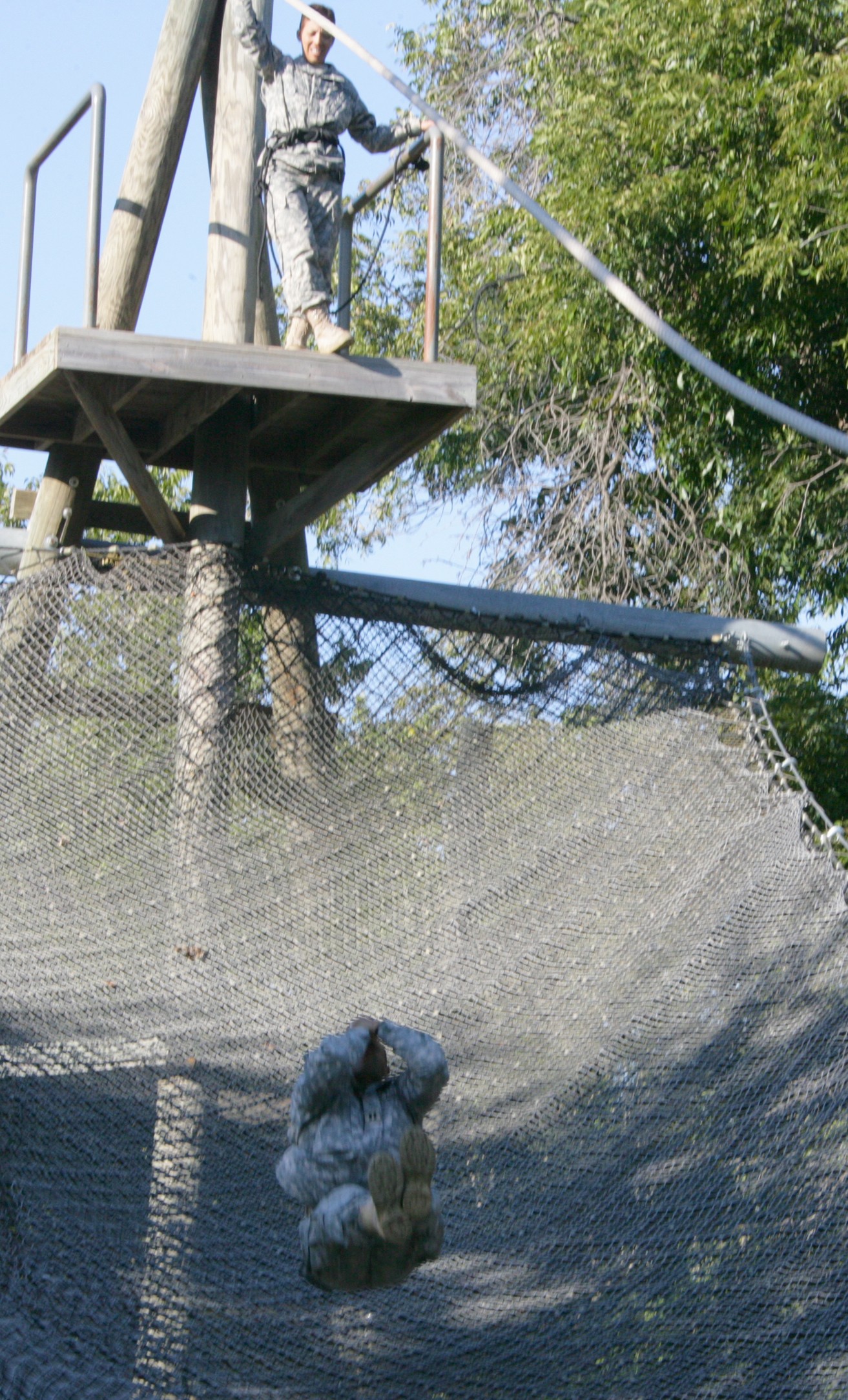
FORT SILL, Okla.-- Special instructors from Fort Sill Range Control train the post's drill sergeant on safe and proper techniques to negotiate their way through a basic combat training obstacle course so they can lead Soldiers and display -- confidence on high.
Five D Battery, 1st Battalion, 19th Field Artillery drill sergeants and their battery first sergeant and commander were certified on the elevated obstacles at the confidence obstacle course Oct. 6.
For Fort Sill's considerable drill sergeant cadre this training is nothing new. They go through this training annually to ensure those who lead, properly train Soldiers on all challenging aspects of the course.
Because safety is so critical to successfully move 200-250 Basic Combat Training Soldiers through the confidence course, much of the instruction centered on the responsibilities of each required position or safety on a particular obstacle. "We stress safety first and safety always," said Ulysses Mays, a special instructor with Fort Sill Range Control. "Because these safety precautions won't be available when Soldiers deploy, when they train here we have to be as safe as possible to best prepare them for combat."
Perils and injury were still a possibility from a misplaced step or lack of attention to instruction or the task at hand all on the seemingly benign confidence course.
Instructors focused their training on five elevated obstacles: the Slide to Freedom, the Tough One, the inverted rope descent, the Skyscraper and the confidence climb.
"Our job is to teach drill sergeants so they in turn can teach our young Soldiers. Once we take them through this training, those Basic Combat Training Soldiers are their responsibility," said Travis Ridings, special instructor.
Training began with two essential knots the Australian seat used for rappelling and the bowline knot, a strong anchor knot. Because drill sergeants may be training an entire battery of Soldiers, time doesn't pass quickly getting everyone through the course. Special instructors taught the Australian seat as an alternative to the Swiss seat. Ridings said the "land down under" seat offers a great deal more comfort then its finely crafted counterpart.
After a couple demonstrations, drill sergeants practiced tying the knots until such time as they showed sufficient proficiency.
Following knot tying and a quick review of wearing a safety harness, the drill sergeants completed each obstacle in the same manner a Soldier would. They also manned each safety position to ensure the obstacle was completed safely.
The Slide to Freedom began with a roughly 10-foot climb up a wooden lattice followed by walk across a narrow beam. Should anyone lose their balance and fall, three-foot thick foam pads would break their fall, instead of the ground breaking their bones. Once across the beam, the drill sergeants ascended another lattice to a tower when they hooked into a pulley and rode a descending cable to an awaiting platform. Other drill sergeants secured them to the pulley, acted as a brake person to arrest their momentum down the cable and finally to detach them from the pulley assembly. Each drill sergeant occupied all positions before moving onto the next obstacle.
At about 30 feet in height, The Tough One looks every bit its name and a daunting obstacle. Once Soldiers conquer this behemoth of rope and wood, they will likely gain confidence to master most any task or challege they face. Ridings said the drill sergeant who sits on high must ascend with complete confidence and appear comfortable as he ties in his safety harness.
"You must appear relaxed and in control up there, because if you show you're afraid of heights, those Soldiers will pickup on that and be fearful too," he said. "Set a good example, lead with confidence and they will follow you."
Just getting to the obstacle's peak is a challenge in itself. Whether he drew the honor from rock, paper, scissors, or just by being in the wrong place at the right time, Drill Sergeant (Sgt. 1st Class) Keven Parr stepped forward to lead the other drill sergeants to the top.
He first ascended a 10-foot length of rope, crawled between a couple beams, walked across some more narrow beams then clambered up an A-frame ladder to the pinnacle. Once there, no handholds were present other than the log he sat astraddle.
Perched high aloft, he then displayed the calm of his cadre, tying himself to the log while awaiting two other drill sergeants who made their way up, over to the top beam, paused for a moment to collect themselves, then descended the cargo netting.
Ridings reminded the drill sergeants to make sure all Soldiers stop about three feet above the foam padding, fall backward and cover their faces before hitting.
He said hitting the pads feet first could result in a twisted ankle or more severe injury.
The next obstacle, the inverted rope descent requires Soldiers to clamber down the rope feet first.
Ridings said this requirement was a recent change as a BCT Soldier at another post attempted to go down head first, fell off the rope and died as a result of how her head impacted the cargo netting below.
The special instructors again pointed out the various safety requirements and made sure drill sergeants insist Soldiers follow all precautions.
"If Soldiers' feet come off the rope and they are dangling from the rope, order them to let go immediately to help prevent injury," said Mays.
He said this because Soldiers may attempt several times to regain the rope and exhaust themselves which may lead to an awkward fall to the netting.
"Tell them to let go, get into the L position, cover their faces and roll down the net," he said.
Drill sergeants then conquered the Skyscraper, a series of raised platforms that requires four to six Soldiers to work as a team and get all members up each succeeding platform then back down to the lowest level. Instructors pointed out some effective ways to move each team member up or down the levels. They wrapped up with the confidence climb, a series of parallel beams that Soldiers had to climb up and back down to successfully complete their training.
Having passed all requirements for their annual training, Ridings said their certificates would be available the following day, and with that certification, Range Control's participation in training would be minimized to special circumstances.
"Although special instructors are available if drill sergeants need us, once they complete this training we have complete faith in their understanding and expertise to lead Soldiers through this obstacle course," said Ridings.

Social Sharing